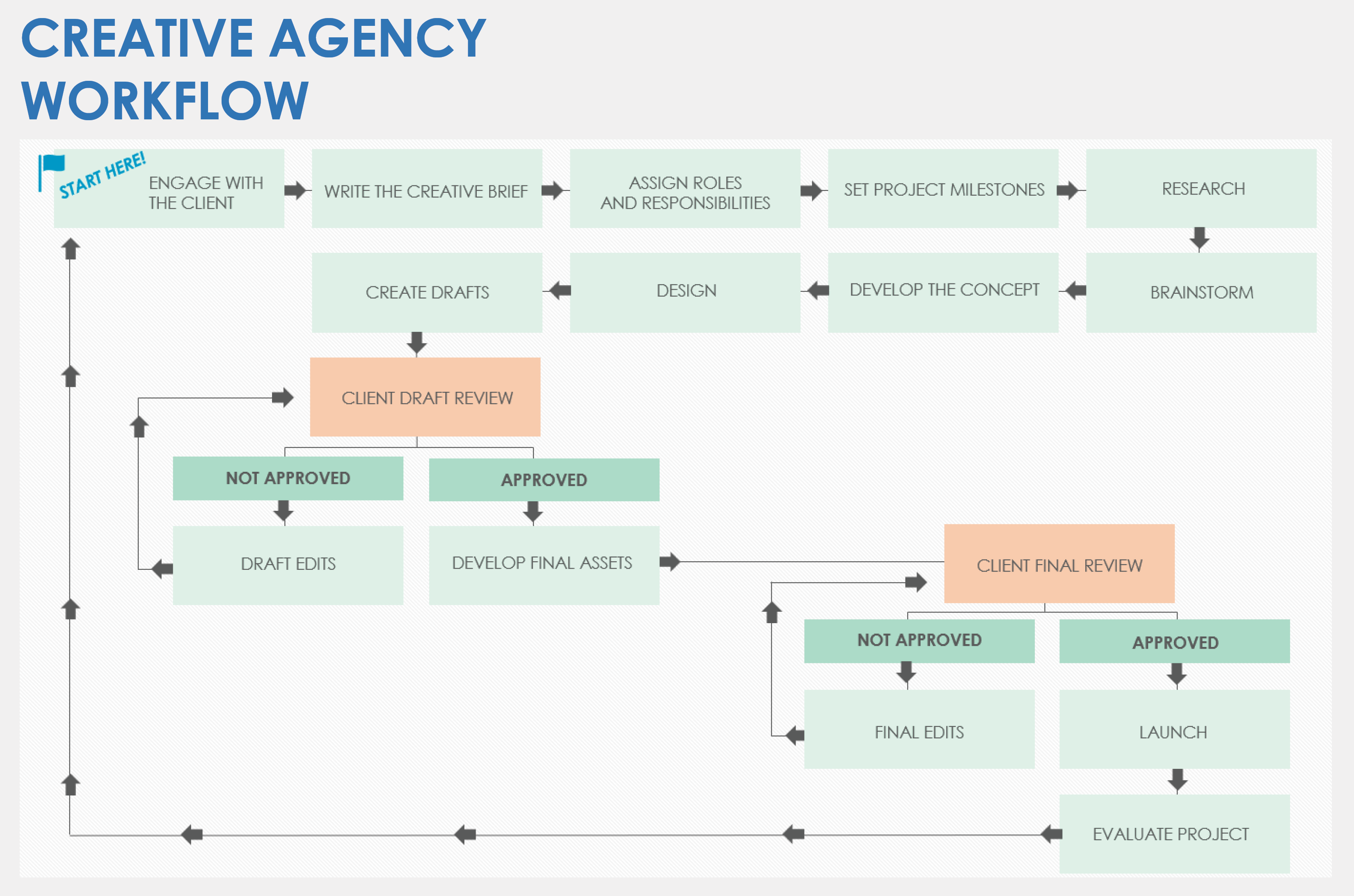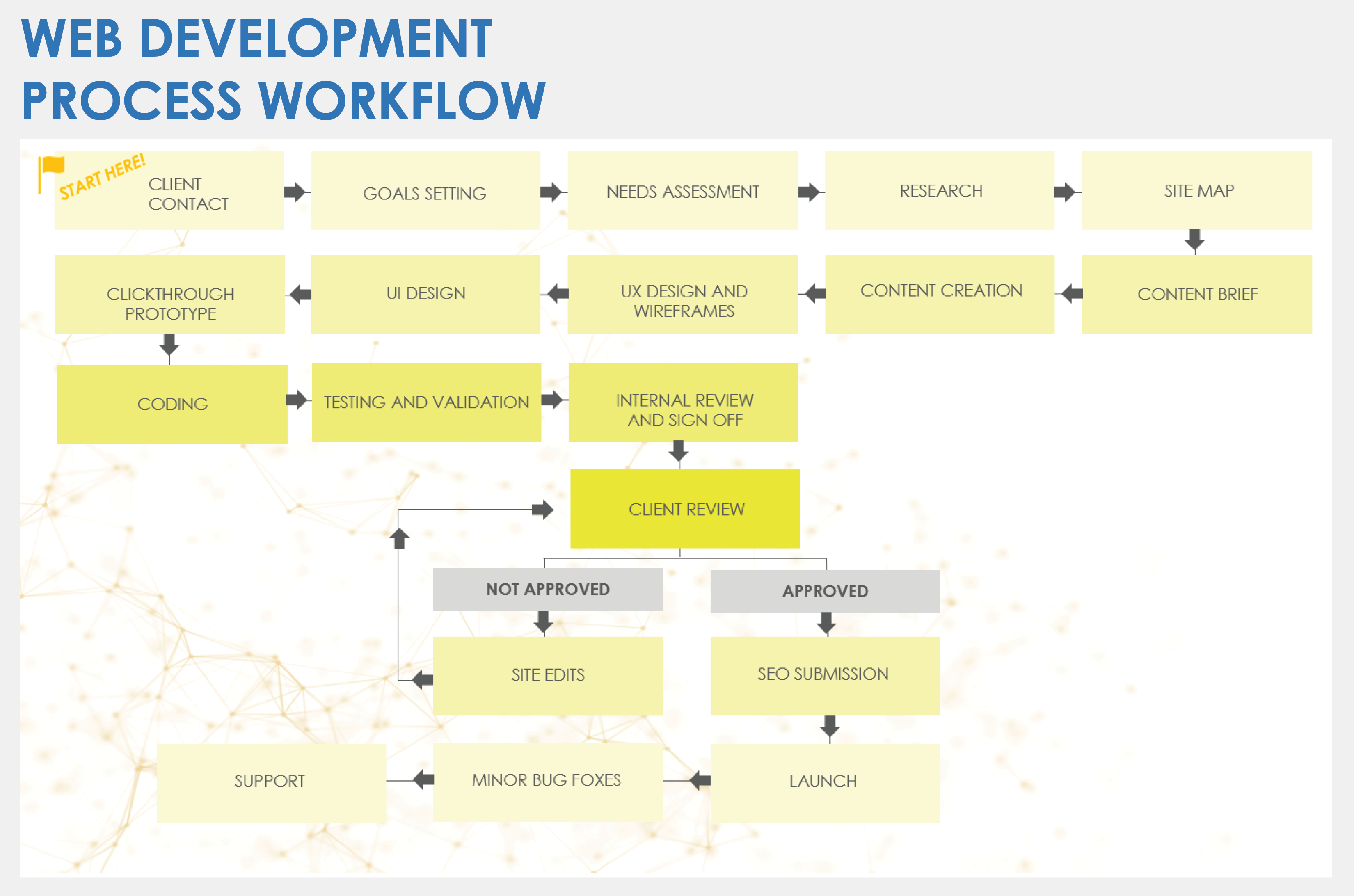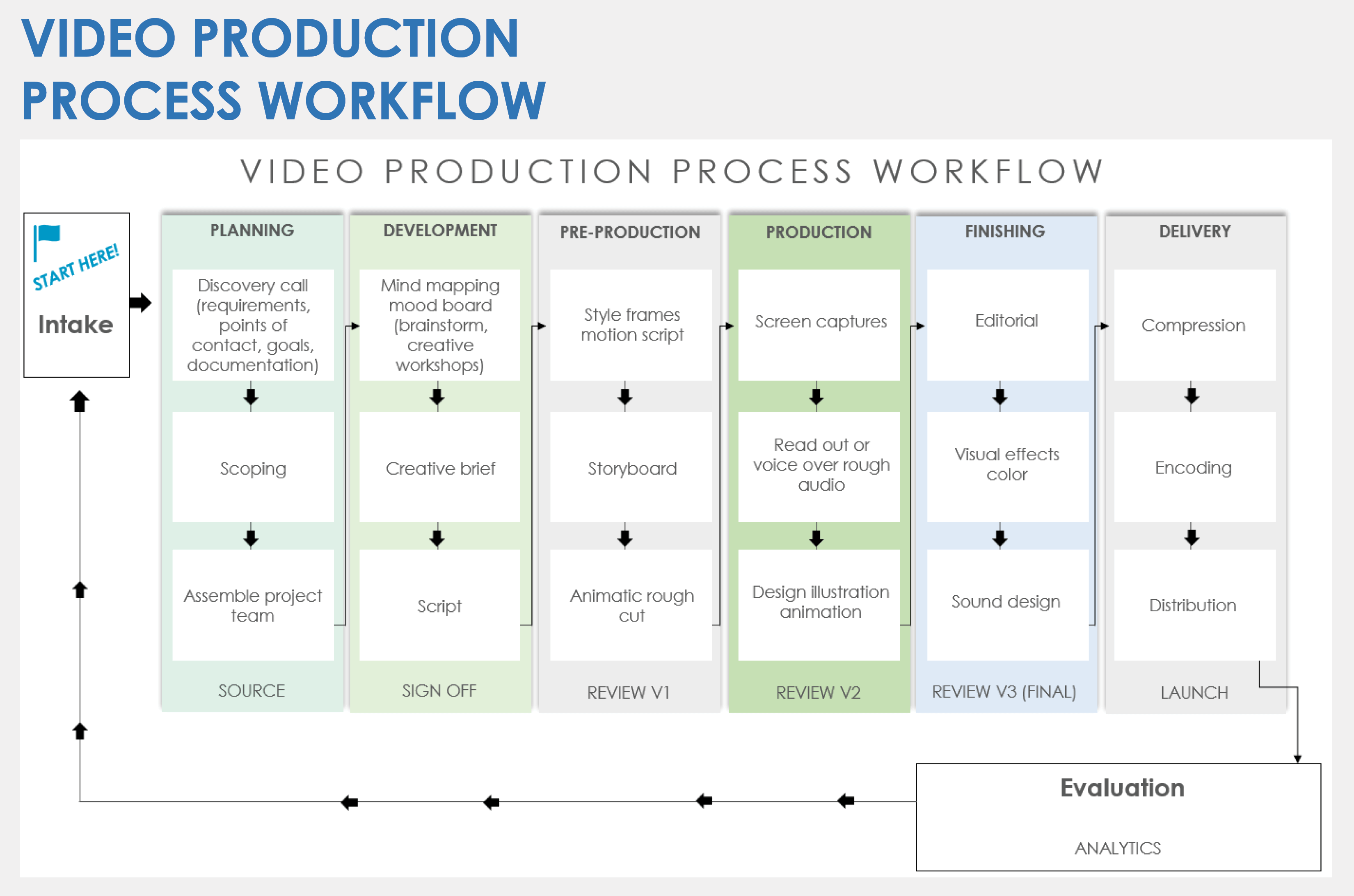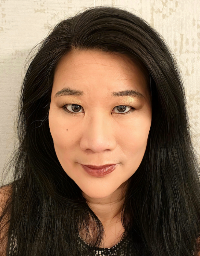What Is a Creative Agency Workflow?
A creative agency workflow is a systematic approach that guides projects from concept to delivery. Managing the entire process for each content piece, it outlines a sequence of steps to ensure efficiency and optimal results.
Although the stages of the workflow might vary depending on the type of project, the process usually includes the following phases: definition and planning, creation and development, review and approval, and launch and evaluation. Whether it's advertising, design, digital content, or another creative field, an effective workflow provides consistency throughout the creative agencies’ processes.
Phases and Steps in a General Creative Agency Workflow
In a creative agency workflow, steps are detailed versions of the general phases. The steps in each phase can vary. For example, an agency has different steps but the same phases when working on a video vs. building a website.

Definition and Planning Phase
During this initial phase, you meet with the client to understand their requirements; define goals, roles, responsibilities; and determine project scope. Learn more about managing project scope.
- Engage With the Client
Understand their needs, goals, target audience, brand voice, and any specific preferences. This initial step creates the foundation for the entire project and ensures the creative direction aligns with the client's vision.
- Write the Creative Brief
This document serves as a roadmap for the project, summarizing key information gathered from the client. The brief serves as a reference point throughout the creative process. Use a creative brief template to ensure you include all the key elements of your design.
- Assign Roles and Responsibilities
Identify the team members who will be involved in the project based on their expertise and assign specific tasks and responsibilities. This step increases the workflow’s efficiency, sets clear accountability, and helps optimize resource utilization.
- Set Project Milestones
Establishing key milestones throughout the project timeline helps you track progress, manage deadlines, and keep the project on schedule. These milestones serve as checkpoints and help your agency complete the deliverables within the agreed timeframe.
Creation and Development Phase
Once you set the project scope, it's time to enter the creation phase where you develop ideas that your team will turn into deliverables.
- Research
Gather information and data relevant to the project goals and target audience. This could include market research, competitor analysis, user research, or industry trends. Conducting thorough research ensures the creative work is based on a solid understanding of the subject matter.
- Brainstorm
This collaborative exercise brings together team members to generate ideas and concepts. This exploration step allows for diverse perspectives and helps spark innovative solutions. If your team is feeling blocked, try one of these brainstorming activities.
Develop the Concept
Take the time to refine ideas and turn them into tangible concepts that can be further developed. This stage involves iterating on initial ideas, adding details, and aligning the concepts with the project objectives.

Tom Molnar, Operations Manager at Fit Design
“The most critical phase is the concept development and initial ideation process,” says Tom Molnar, Operations Manager at Fit Design. “This is where the overall direction and creative approach for a project is determined, as it sets the tone for the entire workflow. Getting this phase right is crucial for us to deliver a successful and impactful final product.”- Design
Create the visual elements of the project, such as layouts, color schemes, typography, and imagery. The design should be visually appealing, functional, and consistent with the brand identity and the creative brief.
- Create drafts
Based on the concept and design, in this step you produce the first drafts of your product deliverables. Before these drafts are ready to be shared with the client, they must undergo an internal review for feedback. Based on team critiques, validate that the drafts align with the project’s objectives, refine the ideas and designs, and select the best ones to present to the client.
Review and Approval Phase
This phase occurs right before launching the content. The creative work is complete and ready to go through client review cycles to guarantee alignment. Once complete, the creative team will make any adjustments to refine the final product.
- Gather Client Feedback
Share your work with the client, and collect their thoughts and suggestions on the work in progress. This step allows you to identify areas for improvement, ensure alignment with expectations, and make adjustments to refine the design.
- Go Through Revision Cycles
This iterative process involves incorporating client feedback and refining the design or specific deliverables. It’s important to establish clear revision cycles to help manage expectations and maintain an efficient workflow. Define the number of revision rounds and specify turnaround times. Make the necessary adjustments until you obtain the final sign-off.
- Develop Final Assets
This step involves any additional production after the initial client approval. It might include creating marketing materials, preparing files for printing, or developing website elements. Remember the client needs to review and approve the final assets before launch, so schedule enough time for this step.
Launch and Evaluation Phase
Having secured client approvals, you need to prepare the content for publication and move to the final step: launching the content and measuring its success using the parameters set during the definition and planning phase.
- Launch
This stage marks the release of the completed project. Launching the content could involve publishing a new website, launching social media campaigns, or distributing printed materials, among other activities.
- Evaluate the Project
This final step involves assessing the project's success against initial goals and objectives. Evaluation might include analyzing performance metrics, identifying areas for improvement, and sharing insights with the client.
Creative Agency Workflow Diagram
The creative agency production process workflow can be divided into 14 steps and four main phases.

Download a Creative Agency Workflow for
PowerPoint
| Google Slides
Key Components of a Creative Agency Workflow
A creative agency workflow relies on several interconnected elements, each playing a vital role in project execution. A successful workflow relies on strong communication, thorough briefs, adequate resources, deadlines, and clear revision cycles.
While creative agencies thrive on adaptability to accommodate unique client needs, it's crucial to maintain process structure through creative operations management and ensure a well-defined workflow that guarantees project efficiency. The balance between flexibility and structure helps teams navigate unexpected situations while adhering to established processes for top quality and timely delivery.
By effectively integrating the following key components, using a project management strategy for creative work, agencies can optimize their workflow to deliver consistent results.
- Effective Communication: Open communication is not only crucial within the agency’s internal teams but also in the relationship with the client. Maintaining a continuous dialogue throughout the project builds trust and collaboration. Make sure to actively listen to your client and incorporate their feedback; that way you stay aligned with their vision.
- Comprehensive Project Briefs: Straightforward briefs serve as the blueprint for the project, clearly outlining objectives, target audience, deliverables, and any specific requirements. It sets the stage for efficient execution and aligned expectations from the outset.
- Optimized Resource Allocation: Strategically assigning tasks based on team members' strengths and expertise maximizes productivity and ensures each task is handled by the most qualified individual.
- Clear Timelines: Establishing clear timelines provides a structured overview of the project’s phases, milestones, and deadlines. This structure enables efficient time management and keeps projects on track.
- Milestone Setting and Tracking: As mentioned before, milestones serve as checkpoints and ensure deliverables are completed within the agreed timeframe. Regularly monitoring progress toward set milestones allows for early identification of potential roadblocks and timely adjustments.
- Structured Revision Cycles and Quality Control: Implementing clear revision cycles allows for controlled client feedback and iterative refinement of your work. Throughout the project lifecycle, make sure to apply quality control measures to identify and address any potential issues early on.
Web Development Process Workflow
The web development process workflow shares core principles with the general creative agency workflow. However, the process differs in its specific steps to cater to the unique nature of website creation. Steps include creating a site map, designing the user experience (UX) and the user interface (UI), coding, testing, bug fixes, and sometimes providing support.
The web development process workflow consists of these phases:
Planning and Research Phase
In this phase, collaboration with the client is key to clarify their vision and requirements for the website. Additionally, extensive research is conducted to build the site's architecture.
- Client Contact: The initial engagement with the client to understand their needs and the project requirements. During the initial meeting, identify the website's purpose, target audience, and desired features.
- Goals Setting: Based on the client’s input, determine what the website needs to achieve, who it's for, and the kind of content necessary.
- Needs Assessment: In this step, identify what you need to build the website. You’ll choose the right platform, identifying any special features and how the website will connect to other systems if needed.
- Research: Gather information and inspiration. Learn about the competition, understand user behavior, and find relevant keywords to help people find the website online.
- Site Map: Create a visual plan that shows how the website pages will be connected and organized, making it easy for users to navigate.
Content Phase
With a clear project scope established, the focus shifts to content development. This phase involves crafting a content brief and generating all necessary content.
- Content Brief: A detailed instruction sheet for the writers who will create the content for the website. The document specifies what to write for each page, who the target audience is, and which keywords to include.
- Content Creation: Writers craft engaging and informative content that aligns with the website's goals and user needs. Refine the content to ensure it's accurate, clear, and optimized for search engines.
Design and Development Phase
This critical phase bridges creative and technical aspects, including UX and UI design, coding, and testing. Once the site meets all functional and design specifications, share it with the client for review.
- UX Design and Wireframes: This step focuses on designing the website's layout and functionality in a way that is user-friendly and intuitive.
- UI Design: Designers create the look and feel of the main pages, including colors, fonts, images, and how buttons and other elements will appear.
- Clickthrough Prototype: Build a clickable mock-up of the website that allows you to see how it will work. This step helps identify any usability issues and ensure the design is on the right track.
- Coding: In this step, programmers translate the designs and functionalities into code, building both the visual elements users see (front end) and the behind-the-scenes technical aspects (back end).
- Testing and Validation: The entire creative team gives the website a thorough checkup to ensure everything works properly. Check for bugs, compatibility across different devices, and overall performance before showing it to the client.
- Client Review and Approval: Show the website to the client and gather feedback to identify areas for improvement and make adjustments to refine the website. Go through the established revision cycles until you obtain the final sign-off.
Launch and Support Phase
After receiving client approvals, in this phase you prepare the website's public release. Post-launch, the focus shifts to providing support to address any issues or needs for updates.
- SEO Submission: List the website with search engines and provide relevant information to help it rank higher in search results.
- Launch: The website finally goes live and is accessible to the public.
- Minor Bug Fixes: This step involves fixing any minor bugs discovered after launch.
Support: If included in your project’s scope, support can include updating content, fixing any technical issues, and ensuring the website remains secure and up to date.

Download a Web Development Process Workflow for
Video Production Process for a Creative Agency
A video production project is an example of a process that, while adhering to the described general workflow, requires a distinct approach from intake to launch. Video production phases include planning, development, pre-production, production, finishing, and delivery.
Each project culminates with an evaluation, where analytics are used to assess the outcome and, if necessary, engage with the client for further refinement. Central to the workflow are the source, sign-off, and multiple review stages at each milestone, ensuring a cooperative process. This meticulous approach ensures that every creative piece is refined before its launch.

Download a Video Production Process Workflow for
Discover more examples of marketing workflows and how to implement them.
How to Identify Bottlenecks in a Creative Agency Workflow
In order to streamline your agency's workflow you must be able to identify the stages where the process slows down. These stages, also known as bottlenecks, impact productivity and lead to delays.

Elaine Chen, Founder and Lead Marketer of the marketing consultancy Excogita, identifies the lack of information as a common cause for bottlenecks in the creative agency workflow. “Creative teams need to be provided with the right input. That’s crucial. Clear and accurate information will allow the creative team to come up with a great new idea. That’s why I believe the briefing process is a critical portion of this workflow as the teams need to have that information upfront.”
The most common issues that affect your workflow are related to:
- Ineffective Communication: Always have an open communication flow with your client, and within your team, to ensure that you’re sharing information at every stage of the process.
- Unclear Briefs: Make sure that briefs are clear and complete to avoid confusion. You can implement standardized design brief templates so that all parties involved have a clear understanding of the project requirements.
- Inadequate Resource Allocation: Carefully assess workload and team member skill sets to ensure proper resource allocation and productivity.
- Lack of Established Revision Cycles: Establish clear revision cycles that minimize unnecessary revisions. Set an approval process with defined roles, responsibilities, feedback guidelines, and timelines.
“Bottlenecks cannot always be avoided but can be minimized with the right strategy. Many of the obstacles we face stem from ambiguous project requirements,” agrees Molnar. “To tackle these issues, we implement effective communication channels within the team and with clients, set achievable project timelines, and ensure that all stakeholders have a clear understanding of project briefs and requirements.”
To identify bottlenecks in a creative agency workflow, consider incorporating these tools:
- Project Management (PM) Software: A centralized platform facilitates collaboration and project tracking, and it reduces the chances of miscommunication.
- Time Tracking Applications: Find areas where the team is allocating too much time and find ways to streamline those processes.
- Collaborative Platforms: Facilitate effective collaboration within your team, providing a centralized space for communication, file sharing, and process tracking.
Strategies for Streamlining Creative Agency Workflows
Streamlining the creative agency workflow is a continuous journey, demanding constant evolution. The first key approach to streamline workflows is prioritization.
By establishing a clear hierarchy of tasks based on importance and deadlines, your team can:
- Focus on Critical Tasks First: Ensure projects progress by tackling high-priority items.
- Break Down Large Projects: Divide complex projects into smaller, manageable tasks, making them easier to track.
- Set Realistic Deadlines: Allocate resources effectively and assign achievable deadlines for each task.
- Minimize Distractions: Prioritization helps eliminate unnecessary tasks or activities.
- Optimize Resource Management: Identify resource-intensive tasks and allocate your team accordingly.
Check out this on-demand webinar about improving operations to get tips from creative leaders and project management experts on additional ways to elevate your process. This article on reshaping your teams’ workflows can help you minimize wasting time and improve collaboration.
Another approach that will help you optimize your workflow is the Agile method. Agile iterative methodologies, popular in software development, can be highly impactful in creative workflows. Learn more about Agile project management.
In Agile development, small teams with cross-functional skills work together to produce pieces of software that are shipped at regular intervals. They focus on work that provides the most value to the customer. At the end of each iteration, developers incorporate feedback so they can continuously improve the product and their process.
The Agile methodology offers numerous advantages that enhance project outcomes. By embracing flexibility, encouraging collaboration, and prioritizing iterative progress, teams can achieve successful results.
- Iterative Development: Delivering work in smaller increments allows for continuous feedback and adjustments.
- Adaptive Planning: You must be prepared to adjust your approach based on feedback and evolving project needs.
- Enhanced Collaboration: Agile fosters teamwork by involving diverse team members in each sprint.
- Improved Product Quality: Continuous feedback and iteration lead to a better final product.

Oscar Ramirez, Design Director at Smartsheet
Oscar Ramirez, Design Director at Smartsheet, sees a “huge value in making design an iterative exercise to build a stronger connection with your audience, if you base design iterations on testing data. Each time you leverage a campaign’s testing analytics to retarget it, you’re refining your messaging based on actual user data. If you focus the campaign on those attributes, on an iterative cycle, conversion will be reached.
“The same principle can be applied to the agency production workflows and even localization strategies,” explains Ramirez. “By analyzing user data, you can determine the markets where your product is being researched the most, thus focusing design around user preferences based on factors like language or age groups. Again, continuing to iterate on successful attempts on a cycle based on your goals.”
How to Measure Creative Agency Workflows
Optimizing a creative agency workflow requires continual monitoring and evaluation. Here's where defining KPIs to measure the impact of your strategies becomes crucial. Use the results to assess your workflow’s effectiveness and identify areas for further improvement.
“When working with the creativity process, it is needed to evaluate the effects of the efforts continuously. If evaluations reveal unattractive results, essential adjustments can be made in order to make improvements for future projects. It is fundamental that every project member is participating in the evaluation stage, as many viewpoints will bring greater perspective to the evaluation,” concluded a Creativity Management Study from the Ad Agency Perspective from the Lulea University of Technology.
Key performance indicators (KPIs) provide quantifiable data that helps you assess the effectiveness of processes and identify areas for improvement. To measure the creative agency workflow impact, consider tracking the following KPIs:
- Project Completion Rates: This metric measures the percentage of projects completed on time and within budget.
- Deadline Adherence Rates: Track how often projects are delivered on time.
- Client Satisfaction Scores: Gather feedback through surveys to measure client satisfaction with the project outcome, communication, and overall experience.
- Revisions Iteration Count: Tracking the number of revisions per project helps identify potential bottlenecks.
- Team Utilization: Monitor how effectively your team members utilize their time and skills.

Gianluca Ferruggia, General Manager at DesignRush, says, “Evaluating and refining workflows in a creative agency requires a combination of qualitative and quantitative analysis. We frequently review project timelines, client satisfaction surveys, and team feedback. However, the true measure of success is our ability to adapt and improve with each project while maintaining or elevating the quality of our creative output. A continuous improvement mindset, paired with regular retrospectives, helps us to fine-tune our processes effectively.”
While quantitative data is essential, don't forget about qualitative feedback. Conduct regular team discussions and client interviews to gather insights beyond the numbers. This practice can reveal hidden challenges, identify areas for further optimization, and foster a culture of continuous improvement within your agency.
“Good agencies have a post-mortem meeting. It’s a great opportunity for all the involved parties to be in a room and go through what went really well in the project, but also to discuss the lessons that the team can learn from it,” explains Chen. “In this space, everyone has a chance to express how they felt with the process and share their experience with the client or their colleagues. There's always things that are not just about numbers.”
Read this guide to post-mortem meetings to learn more about the process and discover best practices.
How to Leverage Project Management Software for Creative Agency Process and Workflows
Technology plays a crucial role in streamlining creative agency workflows. By leveraging project management (PM) software and automating repetitive tasks, creative agencies can unlock significant benefits.
PM software acts as a central hub, facilitating efficient project tracking, task assignment, digital asset management, and real-time collaboration. Time tracking capabilities provide valuable insights into how time is spent on individual tasks. By identifying areas where excessive time is allocated, agencies can start to streamline processes and ultimately boost overall productivity. Additionally, collaborative platforms empower teams to achieve effective communication and collaboration by providing a centralized space for discussions and file sharing.
Repetitive tasks, such as report generation, can consume significant time and resources. By automating this type of tasks, you can:
- Improve Staff Allocation: Redirect the team focus toward more strategic priorities.
- Minimize Errors: Automation reduces the risk of human error, ensuring consistent and reliable results.
- Increase Efficiency: Streamlining repetitive tasks through automation leads to overall workflow efficiency and improved productivity.
In conclusion, by selecting the right PM software for your creative agency you will save time and money. Make sure to evaluate your specific needs and identify the features that best address your pain points.
Streamline Creative Agency Workflows with Smartsheet
The best marketing teams know the importance of effective campaign management, consistent creative operations, and powerful event logistics -- and Smartsheet helps you deliver on all three so you can be more effective and achieve more.
The Smartsheet platform makes it easy to plan, capture, manage, and report on work from anywhere, helping your team be more effective and get more done. Report on key metrics and get real-time visibility into work as it happens with roll-up reports, dashboards, and automated workflows built to keep your team connected and informed.
When teams have clarity into the work getting done, there’s no telling how much more they can accomplish in the same amount of time. Try Smartsheet for free, today.